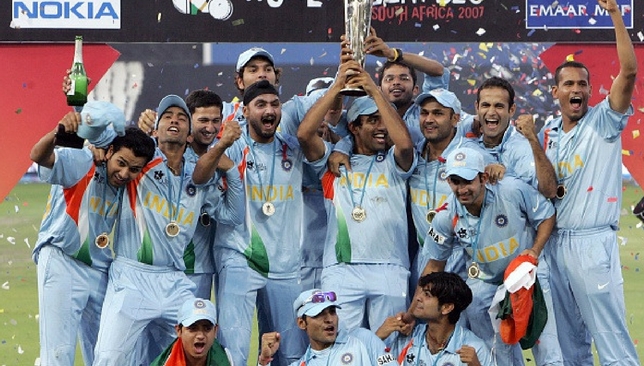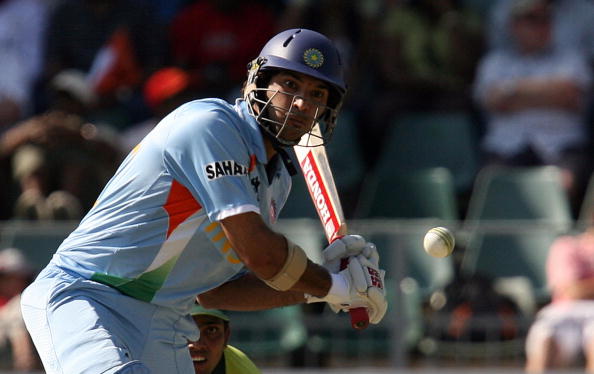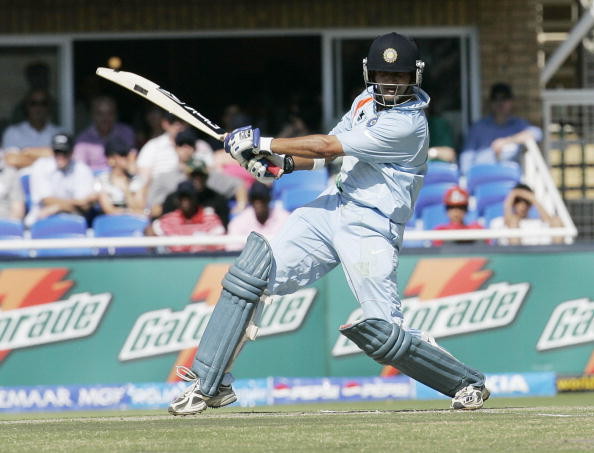
The days succeeding 18 March 2007 were defined by utter dejection and abysmal gloom in India. The nation which boasts of an over-zealous cricketing culture had just scripted a performance in the World Cup which sent its fans into a state of disbelief and heartbreak.
As the disappointment spilled into unpardonable anger towards the cricketing stalwarts, each member of the World Cup team remained confined within the four walls of his house for days.
An air of hatred engulfed India’s favourite sport and much-loved legends were considered villains who had robbed the country of a memorable event due to their lack of intent and will.
Despite Greg Chappell’s exit from the Indian setup and a historic Test series win in English conditions after 21 years in the following months, the images of Tamim Iqbal routing Zaheer Khan remained hard to erase.
A grander victory was needed.
A win which would start a revolution in Indian cricket and one which would eradicate the pain of that awful tournament.
Indian cricket was reeling and it desperately needed its moment of glory.
INDIA’S RELUCTANCE TO PARTICIPATE
After hosting a highly mismanaged World Cup in the Caribbean Islands earlier in the year, the ICC remained vastly concerned over the dwindling interest that Test and ODI cricket were garnering.
In desperate need of a format which synced with the generation’s fast-paced lifestyle, the governing body recommended the initiation of a World Cup in the T20 format, which was a desperate step to check the falling audience turnouts in stadiums.
However, the ICC faced its biggest revolt from the Board of Control for Cricket in India (BCCI), who supported the event but refused to be drawn into this experiment.
Categorically stating that India would not participate in the inaugural T20 World Cup, Niranjan Shah, the then Secretary of the BCCI, remained apprehensive of the format.
With just one T20 international against South Africa under India’s belt, Shah’s fear remained a concrete and justifiable one.
Aware that a global event without India remained a fruitless exercise, the ICC hurriedly and shrewdly changed their clause and stated that participating in all ICC-sanctioned events, especially the World T20, remained a criterion for a nation if they harboured hopes of hosting the 2011 World Cup.
India, who were already making their intentions clear of having the 2011 event staged on home soil, this latest development left them in a state of helplessness and as circumstances panned out, very reluctantly agreed to send an Indian team to South Africa for a tourney which changed their fortunes forever.
A WASHOUT, A BOWL-OUT AND A CLOSE LOSS
Just days before the list of probables had to be named, the veterans of the Indian 50-over team – Sachin Tendulkar, Sourav Ganguly and Rahul Dravid – pulled out, preferring to give youngsters an opportunity in a format which demanded younger and fitter legs.
MS Dhoni was left in charge of the Indian team for the first time in his career, with a squad comprising of exciting and upcoming talents, namely Rohit Sharma and Yusuf Pathan, and experienced players like Virender Sehwag, Irfan Pathan and Harbhajan Singh.
With relatively low expectations hovering around them, the Indian team set foot in Durban to play Scotland without any warm-up games under their belt, courtesy a packed schedule that preceded the fortnight-long competition.
After facing a washout against the minnows, India suddenly found themselves up against their arch-rivals Pakistan, without any prior experience of playing together as a unit.
Playing Pakistan in a must-win game early on in the tournament had its own challenges. Rattled by Mohammad Asif’s early wickets and searing pace, the Indian batsmen managed only 141/9 in their 20 overs, with a handy contribution of 50 in 39 balls from Robin Uthappa.
Just when the total seemed an inadequate one and an early exit once again doomed large, the Indian bowlers displayed great accuracy with the ball in hand, by taking wickets at regular intervals, leaving Pakistan with 12 runs to get off the final over.
Two boundaries by Misbah-ul-Haq to equal the scores sent Indian fans into a state of agony, but Sreesanth – for once – was calm under pressure and did not concede a single run off the last two deliveries, which included a tight run-out off the last ball.
The first of its kind; a bowl-out ensued in the aftermath of the tied game which was easily won 3-0 by India.
Dhoni’s astute captaincy, wherein he went for slower (including a couple of part-time) bowlers like Sehwag, Harbhajan Singh and Uthappa in the bowl-out, rather than with full-time bowlers, which Pakistan preferred, was the early sign of an unorthodox leader who would be responsible for taking India to great heights in the years to follow.
Facing a tricky New Zealand side in the Super Eights, the Indian team suffered a tough 10-run loss. Chasing a steep 191, the Indian openers provided a solid foundation before Daniel Vettori spun his magic, restricting the Men in Blue to 180.
With two wins required in the next two matches to advance to the semi-finals, India had a tough task ahead of them. England and hosts South Africa were the upcoming contests and not surprisingly, experts did not give the young team much of a chance.
YUVRAJ’S SIX SIXES, A CHOKE AND AN UPSET
The first of those battles was against England on September 19. The match started with aplomb as the Indian openers amassed a massive 136 runs for the first wicket. A target of 190+ looked a clear possibility after 18 overs with 171 runs already on the board.
However, it is what followed thereafter that has remained etched in every Indian cricket lover’s mind, sending people into raptures of nostalgia every time Yuvraj Singh’s famous six sixes are mentioned.
Andrew Flintoff had a few words to offer Yuvraj before the start of Stuart Broad’s over in a bid to unsettle the dangerous left-hander.
Choosing to answer the maverick all-rounder with his bat instead, Yuvraj smashed a distraught Broad for 36 runs in an over, becoming the first player in T20 history to hit six sixes in an over.
Despite a challenging fightback from the English batsmen, the target of 219 always seemed out of their reach.
A new found confidence seemed to envelop the Indian mind-set after the England game, where it looked like that no player would collapse to the strains of pressure but rather outperform his own expectations.
The hosts South Africa boasted of a menacing line-up and Yuvraj, India’s new found deity missed the game due to an injury sustained in the encounter with England. However, rather than succumbing, the Indian cricketers played with renewed intent and it was debutant Rohit Sharma who led the late assault on the home side, with a half-century to his name.
A rather modest target of 153 meant that India needed early breakthroughs if they were to book a place in the final four. A slew of early wickets and some wicket-to-wicket bowling by RP Singh resulted in the famed Protean choke and a dream had been achieved.
Suddenly, the nation woke up to the perils of T20 after the sojourn in Africa. An unlikely World Cup after twenty four years no more seemed a far-fetched reality.
Australia, the ODI world champions, were the next opponents but India were no longer just another team in the tournament.
With Yuvraj back in the fray, an exciting score of 188 was posted by the Men in Blue, achieved largely due to the Punjab batsman’s 30-ball 70.

The Kangaroos, with players like Matthew Hayden, Adam Gilchrist and Andrew Symonds in their ranks, never quite looked in trouble but some late display of immaculate bowling by Sreesanth left Australia needing 20 runs off the final six deliveries.
As the last ball was bowled to script a memorable win, the nation erupted; Indian cricket fans went berserk.
A finale awaited the young team and the joy – that had been evaporated by the disastrous World Cup campaign earlier in the year – finally returned to the cricket-crazy nation once again.
THE GRAND FINALE
India versus Pakistan in a World Cup final for the first time ever in the history of the sport. For the ICC, who were tirelessly marketing and promoting this new format, there could not have been a more befitting summit clash.
For both India and Pakistan, this was an opportunity to create history in front of a packed Johannesburg gathering.
Batting first without the injured Sehwag, India managed 157/5 with Gautam Gambhir stroking his way to a fluent 75, aided immensely by Rohit’s 16-ball 30. A below-par total on a batting-friendly pitch indicated a tough battle ahead for India.

Gautam Gambhir top scored for India in the final
Even though Pakistan managed to keep with the asking rate, brilliant spells of bowling by RP Singh, Irfan Pathan and Joginder Sharma left them tottering at 77/6.
Misbah, once again, held one end up to renew hopes of a late comeback from Pakistan. Three sixes off Harbhajan in the 16th over suddenly turned the momentum immensely in Pakistan’s favour.
By the end of the 19th over, Pakistan needed 13 runs to clinch the coveted title, while India were just one wicket away from a memorable win.
With Harbhajan already having taken a beating from Misbah’s bat, Dhoni tossed the bowl to Joginder Sharma, who had very little experience at the international level. It was a move which bore testimony to the Indian skipper’s intuitive captaincy.
Starting off with a wide and a dot ball, the Indian medium-pace bowler was smashed for a six as the equation reduced to six needed from four deliveries. Aware that a hit over the ropes would mean curtains for India, Dhoni showed first signs of anxiety as the next ball was about to be bowled.
A slow delivery on length outside the off-stump was bowled by Joginder to Misbah, who moved to the offside, in a bid to scoop the ball for a boundary. With the ball in the air, an inexplicable sense of nervousness spread across the stadium.
Displaying an air of nonchalance which contrasted the pulsating atmosphere all around, India’s Sreesanth completed the catch at short fine-leg, sending the nation into a hysterical frenzy.
24 September 2007 – the date still remains etched in each Indian cricket fan’s memory as a day which ushered in a new renaissance for the game in the country with Dhoni being the messiah.
Within four years, the Indian team would clinch the 50-over World Cup as well besides reigning supreme as the number one Test nation. The concept of the Indian Premier League (IPL) flourished after this triumph and Dhoni, in time, would herald a new generation of exciting and promising players who would be responsible for taking Indian cricket to greater heights.
Just like Ravi Shastri’s overtly-excited exclamation when Sreesanth latched on to the final catch keeps resonating through the ears, the after-effects of the grand victory – which instilled a new found self-belief amongst youngsters across the country – is heard and seen even nine years later.